Once a key structure within the architectural complex of the ancient Imperial City of Hue, Kien Trung Palace was forgotten by time for decades. Now, it has returned with a magnificent beauty, becoming an attractive destination for tourists in Hue.
After 5 years of restoration, Kien Trung Palace has officially reopened its doors to visitors, making it a must-see attraction when visiting the ancient capital of Hue. When checking in at Kien Trung Palace, visitors will be captivated by its dazzling and majestic beauty. The structure evokes strong emotions, as it revives a legend that had lain abandoned for 72 years, now standing grandly in the heart of Hue.
Introduction to Kien Trung Palace in Hue
Kien Trung Palace in Hue, also known as Kien Trung Pavilion, stands firm as a symbol of historical architecture, preserving the spirit of the homeland and the essence of the Nguyen Dynasty. Located within the Forbidden Purple City, this structure is not only a historical relic but also a magnificent space showcasing the regality and power of the ancient empire.
The entrance fees for visiting Kien Trung Palace in Hue, updated in December 2024, are as follows:
- Adults & Foreigners: 200,000 VND/ticket
- Children under 1.3m: 40,000 VND/ticket
This ticket price offers visitors the opportunity to explore the site while also serving as an essential fund for preserving and maintaining Kien Trung Palace in Hue.
Where is Kien Trung Palace in Hue?
Kien Trung Palace in Hue is located at 32 Dang Thai Than Street, Phu Hau Ward, Hue City. The opening hours are from 7:30 AM to 5:30 PM every day of the week, providing visitors with ample time to explore the beauty and history of this place. For an enjoyable experience, tourists can visit during spring, when the weather is pleasant and cultural events are often held.
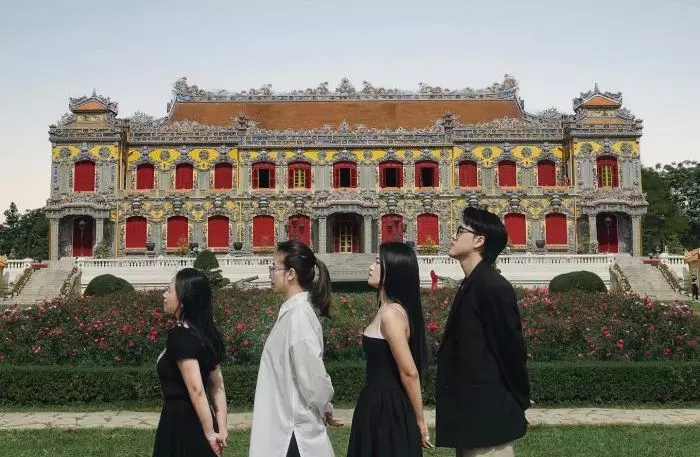
Located about 2.7 km from the center of Hue, Kien Trung Palace in Hue is easily accessible by various means of transport. Visitors can use taxis, buses, motorbikes, or cars depending on their preference and convenience. The route from the city center, as suggested by HueTransferService.com, includes taking Phu Xuan Bridge, turning left onto Le Duan Street, and continuing through smaller streets to reach Kien Trung Palace in Hue.
Kien Trung Palace in Hue is a historical and cultural testament of Vietnam. For those who want to learn about the glorious past of the Nguyen Dynasty and experience the elegant architecture, Kien Trung Palace in Hue is a must-visit destination.
Kien Trung Palace – The Splendid Palace of the Nguyen Dynasty
Kien Trung Palace in Hue, a masterpiece within the grounds of the ancient capital’s relics, stands as a strong symbol of magnificence and splendor in the history of the Nguyen Dynasty. With its unique architecture, it was not only the workplace of great kings but also an attractive destination for visitors, admired for its beauty and the historical value it represents.
History of Kien Trung Palace
Kien Trung Palace is one of the most important architectural structures in the system of Nguyen Dynasty constructions from the early 20th century. The name “Kien Trung” holds a special meaning: “Kien” means to build or establish, while “Trung” implies uprightness.
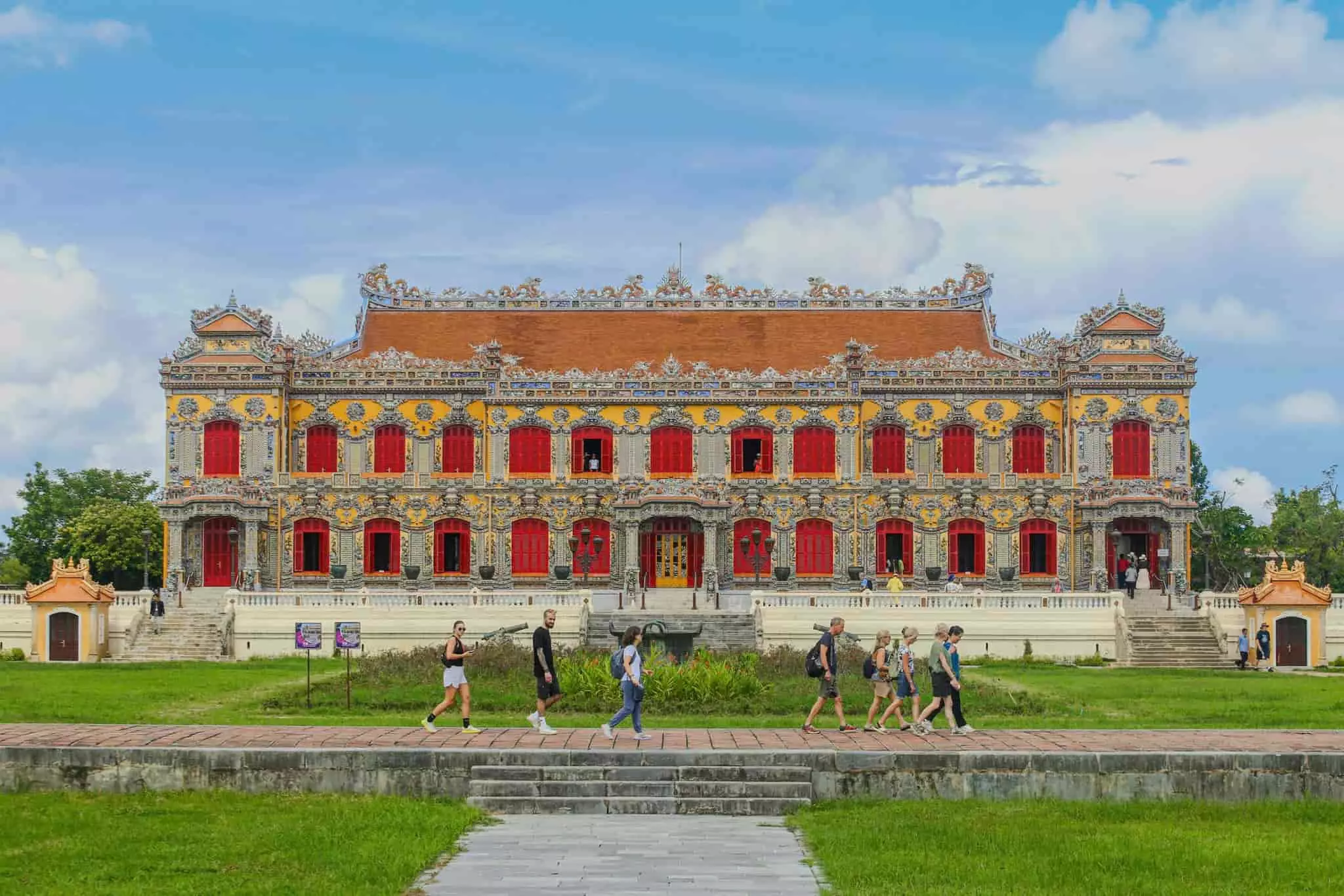
Previously, at the location of Kien Trung Palace, Emperor Minh Mang had built Minh Vien Pavilion, a three-story structure known as “the most beautiful scenery of Thần Kinh.” In 1876, due to severe deterioration, Emperor Tu Duc ordered its dismantling. In 1913, Emperor Duy Tan once again constructed a completely new building, called Du Cuu Pavilion.
Kien Trung Palace was officially built between 1921 and 1923 during the reign of Emperor Khai Dinh. It is one of five major structures aligned along the central axis of the Forbidden Purple City in Hue, alongside others such as Thai Hoa Palace, Can Chanh Palace, Can Thanh Palace, and Khon Thai Residence. During its initial construction phase, Kien Trung Palace was designed in a neoclassical style on a large scale, characteristic of the Khai Dinh period, with intricate and elaborate details. The most notable feature was the decoration using fragments of porcelain and ceramic on a lime mortar base.
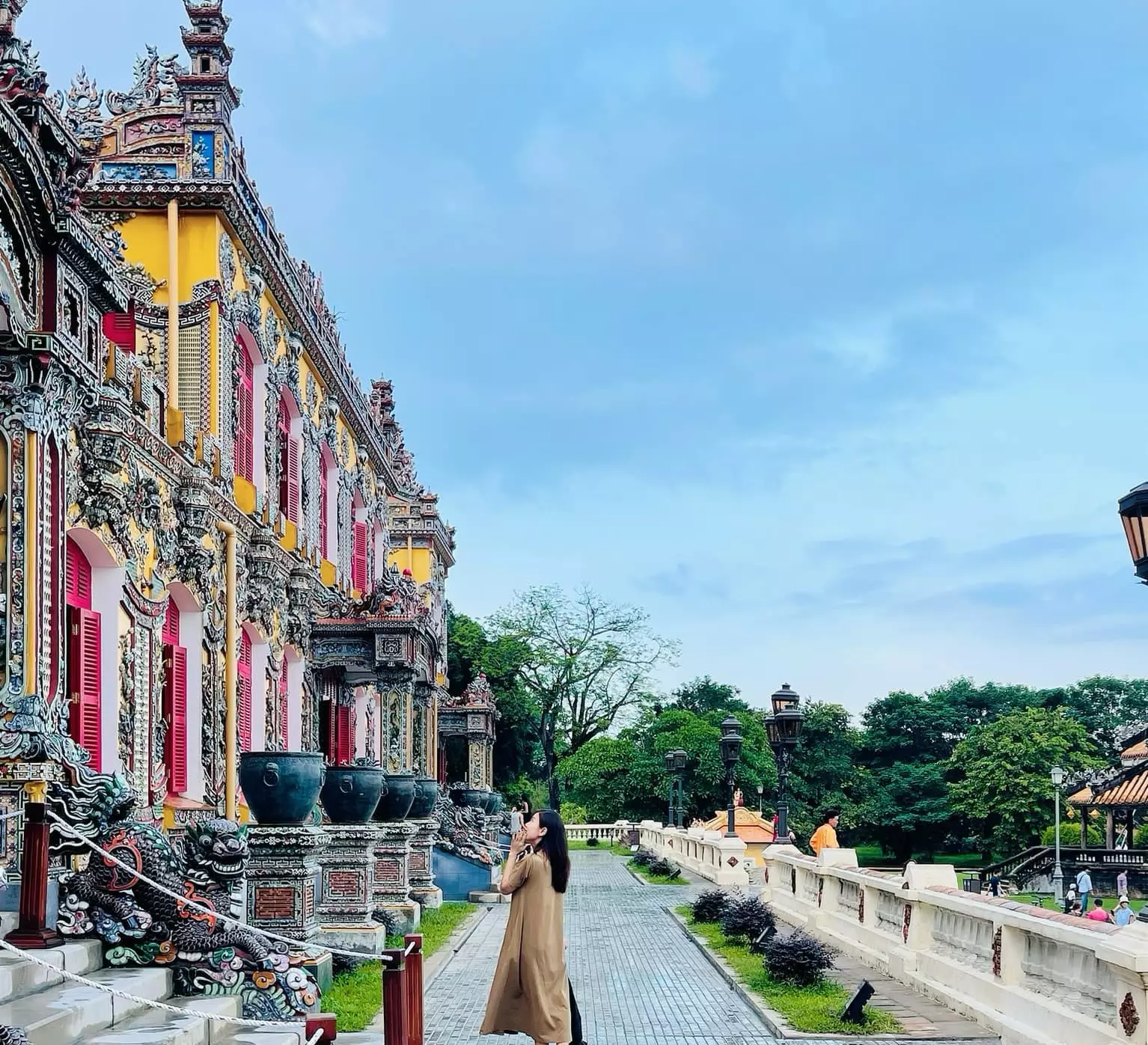
During Emperor Bao Dai’s reign, Kien Trung Palace continued to undergo renovations and additions. After the August Revolution, the palace was used by Emperor Bao Dai to receive delegations from the provisional government and to discuss his abdication, transferring authority to the Provisional Revolutionary Government of the Democratic Republic of Vietnam.
However, in 1947, amid significant historical upheavals, Kien Trung Palace was one of the important architectural structures of the Hue Imperial City and the Forbidden Purple City that was almost entirely destroyed, with only its foundation remaining, marking the end of its short 24-year existence.
On February 16, 2019, the Hue Monuments Conservation Center began the restoration and reconstruction of Kien Trung Palace with a budget of over 120 billion VND (5 million dollars). This restoration project aimed to fully revive both the interior and exterior of the structure. By the Lunar New Year of 2024, Kien Trung Palace officially reopened to the public, becoming one of the most attractive check-in spots for visitors within the architectural complex of the Hue Imperial City.
Exploring the Space and Architecture of Kien Trung Palace
The architecture of Kien Trung Palace embodies both the grandeur and majesty of the Nguyen Dynasty’s royal structures, while also reflecting the essence of Vietnamese architecture from the early 20th century. It combines elements of French and Italian architecture with the traditional style of the Nguyen Dynasty. The space of Kien Trung Palace is divided into three main areas: the garden, the front façade, and the interior.
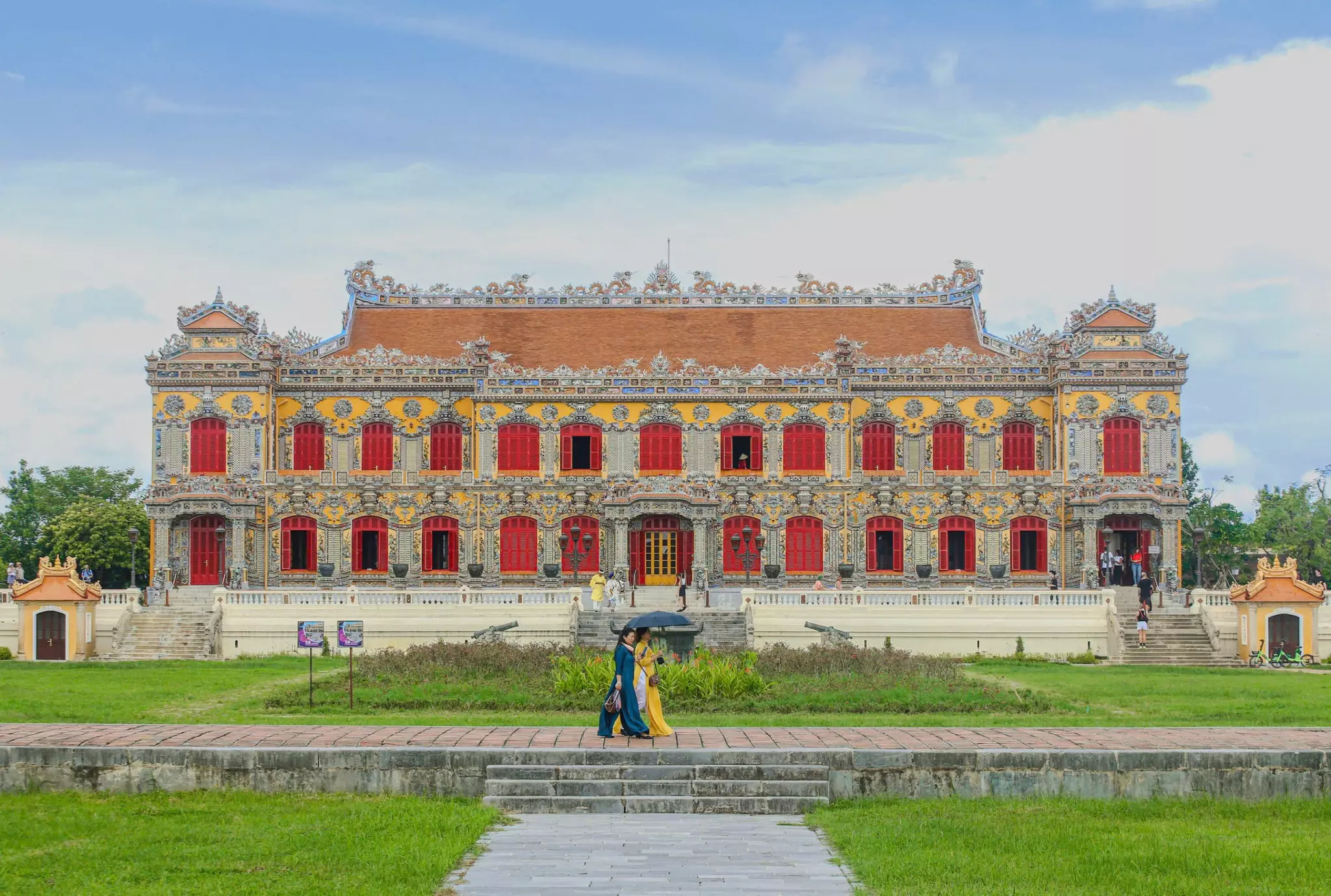
The garden is a vast space with lush green lawns, intricately pruned ornamental trees, and two pavilions designed in an ancient style. The most striking feature of Kien Trung Palace’s architecture is its front façade. This area features three staircases adorned with dragon sculptures, where visitors can ascend to the palace terrace. The main floor of the palace is designed with 13 veranda doors, including five in the central hall, three on each side, and two additional protruding doors at each corner. The upper floor follows a similar layout as the main floor.

The unique feature that highlights the front façade of Kien Trung Palace is the art of porcelain mosaic, featuring very distinctive decorative patterns. The doors are painted in bright red and gold, while the dragon sculptures and decorative motifs made from porcelain mosaics are eye-catching. Notably, the five-clawed dragon motifs symbolize the power of the Nguyen Dynasty on the palace walls. To give the dragons a lifelike appearance, craftsmen skillfully combined various types of porcelain pieces. In addition to dragons, the façade also features mosaic representations of mythical creatures such as lions and qilins.
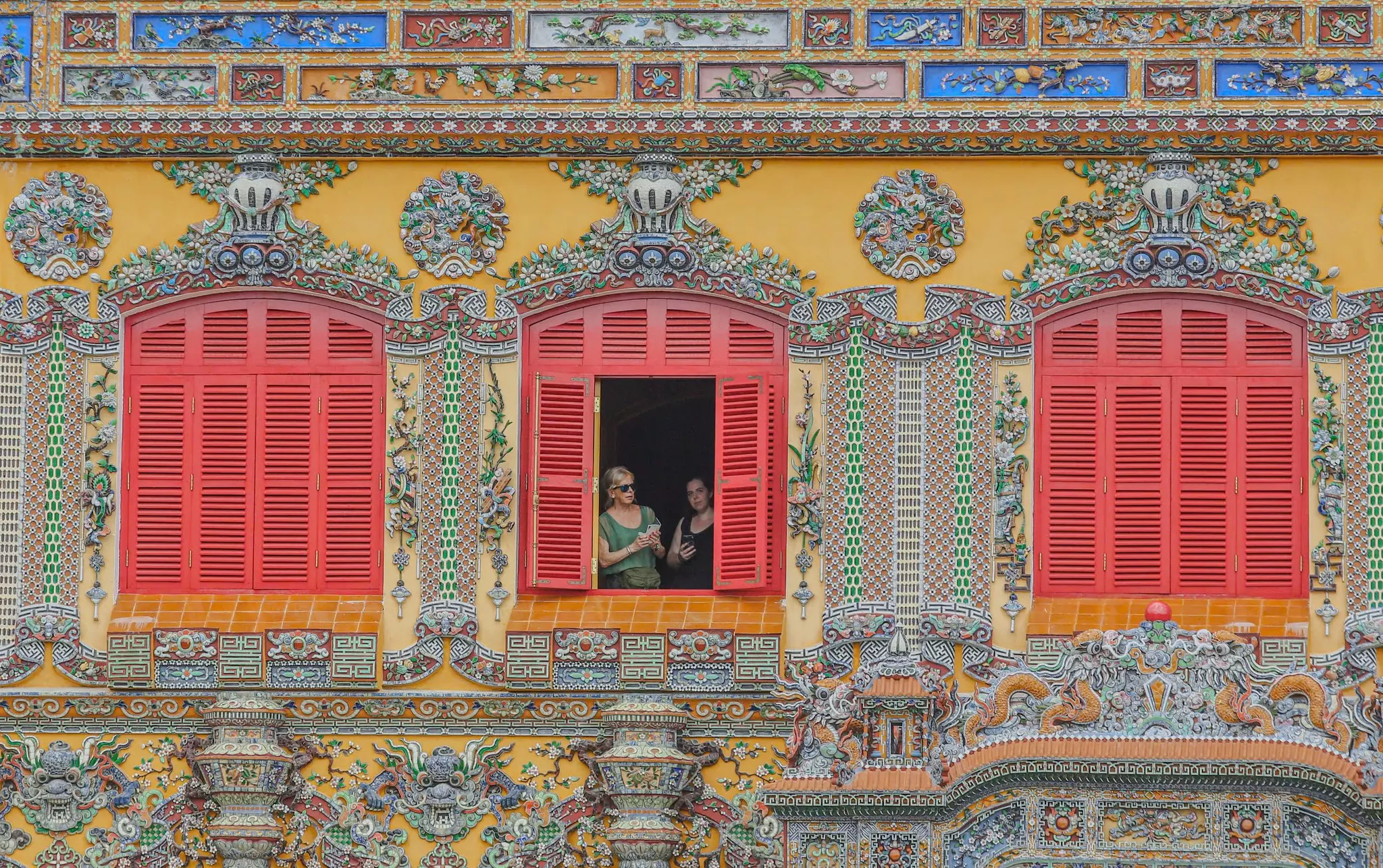
The windows are also painted in vibrant colors, with the outer area adorned with eye-catching porcelain mosaics and dragon-cloud details. The roof of the palace is covered with tiles glazed in gold, complemented by a prominent system of decorative patterns and porcelain mosaics of dragons at the apex of the palace roof.

The interior space of Kien Trung Palace shares many similarities with the interior design of An Dinh Palace. The space exudes a royal and powerful ambiance, predominantly featuring gold along with impressive decorative motifs. Inside Kien Trung Palace, the Hue Monuments Conservation Center showcases valuable artifacts related to the royal family of the Nguyen Dynasty, such as daily garments of Emperor Khai Dinh, the embroidered golden dragon shoes of Crown Prince Vinh Thuy (later Emperor Bao Dai), the royal palanquin, and a mother-of-pearl inlaid cabinet.
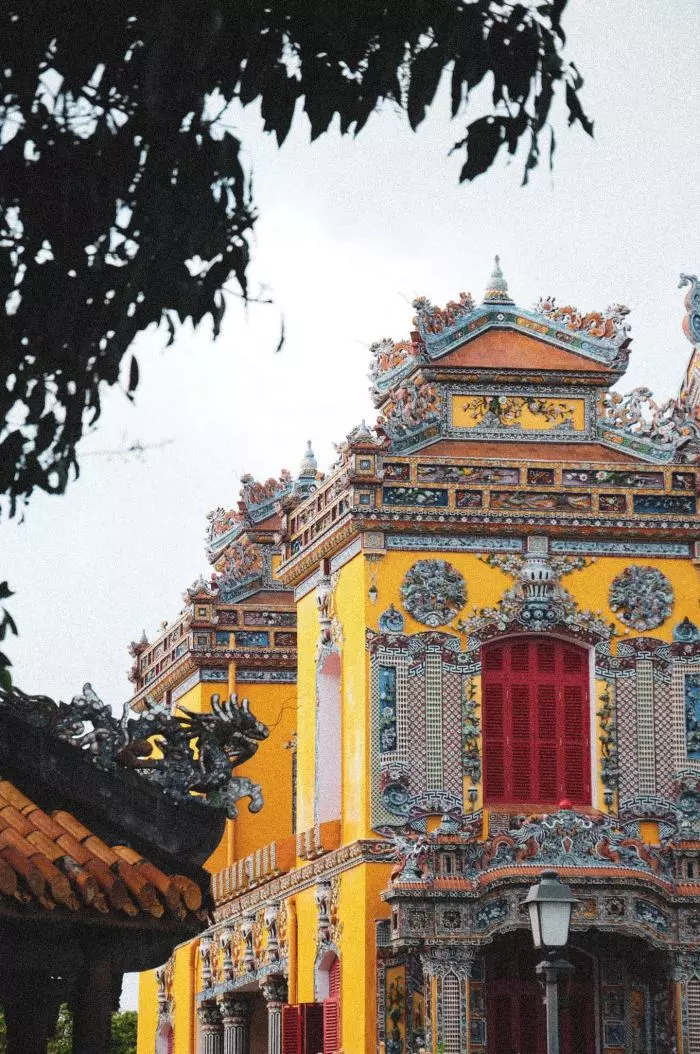
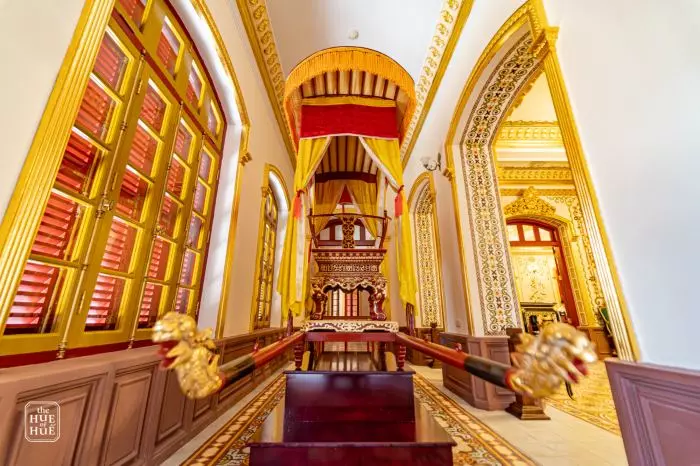
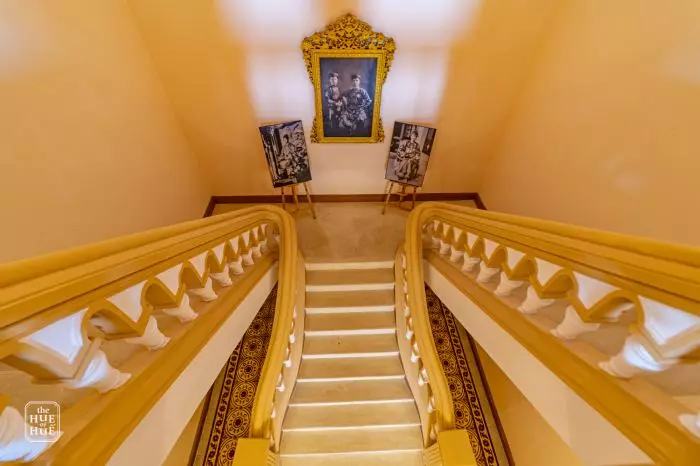
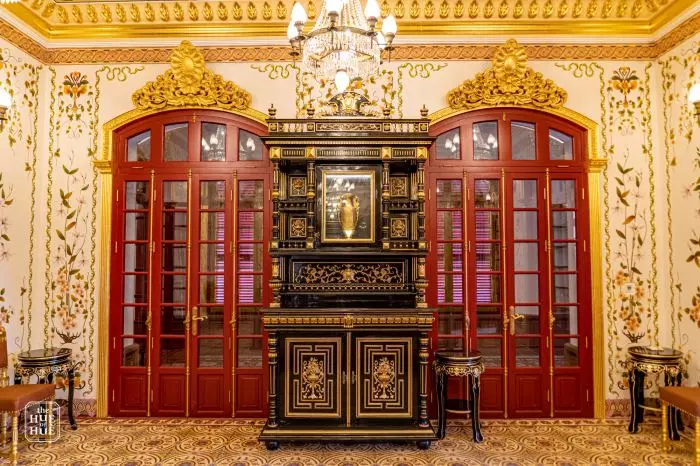
Kien Trung Palace holds significant artistic, architectural, and historical values, embodying all the characteristics of a structure built in the ancient Indochinese style. Along with the stunning Asia-European styled structures from the reign of Emperor Khai Dinh, such as Hien Nhan Gate, Khai Dinh Tomb, and An Dinh Palace, Kien Trung Palace serves as a highlight that enriches the distinctive architectural features of Vietnam during the neoclassical period, showcasing porcelain mosaic art that typifies the architectural landscape of the Hue Imperial City.
Some Tips When Visiting Kien Trung Palace in Hue
Kien Trung Palace in Hue is one of the city’s famous attractions. This magnificent and luxurious architectural structure bears significant marks of Vietnam’s history and culture. To have a complete and meaningful visit, you should keep in mind the following tips:
- Bring a map to avoid getting lost: Given the vast area of the Hue Imperial City and its many attractions, carrying a map in your backpack is a smart idea to avoid getting lost. This will help you feel more confident while exploring and enjoying your journey comfortably.
- Dress respectfully and appropriately: Choose clothing that is both beautiful and suitable for visiting historical sites. This not only creates a harmonious picture with the surrounding environment but also enhances the traditional beauty and solemnity of historical places.
- Follow regulations and be mindful of restrictions: Before your visit, be sure to read and adhere to the regulations of the site, especially regarding restrictions on taking photos of interiors or touching artifacts. Compliance helps protect the heritage and keep it intact.
Conclusion
Kien Trung Palace in Hue is not only a famous architectural structure but also a symbol of the historical and cultural vitality of Vietnam. With its magnificent architecture, profound spiritual significance, and cultural diversity, it attracts millions of visitors each year, helping them gain a deeper understanding of this homeland and seek a connection with the past.

